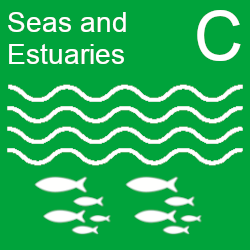Short Description
This indicator will show changes in the natural functionality and extent of seafloor habitats able to support a healthy and productive ecosystem. The indicator is linked to the UK Marine Strategy Descriptor 6 (Seafloor Integrity). The indicator will be derived from the integration of metrics of individual broad habitat types and selected vulnerable habitats. Well-functioning seafloor habitats (physically and structurally) are both productive and sufficiently extensive, to carry out natural functionality, including the necessary ecological processes which underpin ecosystem goods and services, and are capable of supporting a healthy and sustainable ecosystem for the long term.
Readiness and links to data
This indicator is not available for reporting in 2023 in a finalised form. An interim indicator is presented here that shows progress towards the UK Marine Strategy target of achieving and maintaining Good Environmental Status (GES) for 2 benthic (seafloor) habitats (seagrass beds and horse mussel reefs) in UK seas.
The assessments used for this indicator have already been reported under the updated UK Marine Strategy Part One (2019). Data on benthic habitats, analytical methods and assessment are available, including information on the potential physical loss indicator.
The indicator will be updated (both the current assessment and a new assessment for the period 2018 to 2024) during the next round of the UK Marine Strategy in 2024. The indicator may also be expanded to include additional habitats in the future.
Additional measures are being published via the Convention for the Protection of the Marine Environment of the North-East Atlantic (OSPAR) Quality Status Report 2023 which will cover the functionality aspect of this indicator; these measures will be included in a future update to the Outcome Indicator Framework.
Notes on indicator
A graph is not yet presented for this indicator as only a single datapoint is available for both seagrass beds and horse mussel reefs up to the year 2016.
Habitat suitability models and information on activities that will cause irreversible loss of the habitat were spatially overlaid to predict area of potential habitat loss for seagrass beds and horse mussel reefs up to 2016. These habitats were chosen as they are both are very fragile and vulnerable to pressures from human activities. They are also an important food source, refuge, and nursery ground for many species. It is important to note that the outputs from the habitat suitability models show ‘potential’ habitat. This may differ from the ‘realised’ (occupied) habitat.
While the currently available data predate the 25 Year Environment Plan, they provide the most recently available assessment of the condition of benthic habitats. They enable a better understanding of a baseline from which to measure progress towards the goals of the 25 Year Environment Plan when the indicator is next updated.
Indicator components
Trend description for C9
The UK Marine Strategy target for either seagrass beds or horse mussel reefs was not met as the potential extent and distribution of each habitat is neither stable nor increasing. Up to 2016, 32 km2 (2%) of the potential habitat for seagrass beds (Zostera marina), and 39 km2 (0.5%) of the potential habitat for horse mussel reefs (Modiolus modiolus) has been lost. The main causes of potential physical loss to these habitat types are aquaculture, navigational dredging, dredge and spoil disposal, coastal development, and recreational activity.
Assessment of change
No assessment was undertaken for this indicator as a suitable time series is not yet available in the Outcome Indicator Framework.

